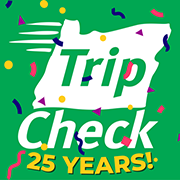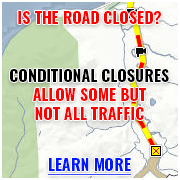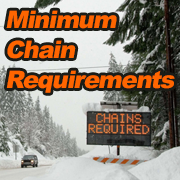ODOT RealTime - Find Out More
Read the ODOT RealTime fact sheet.
What is ODOT RealTime?
ODOT RealTime is a new system that will help make roads safer and help Oregonians get where they're going more efficiently by providing real-time traffic information to drivers. The first ODOT RealTime projects started on Portland-area highways in July 2014.
What kinds of signs are involved?
Travel Time
Travel Time signs, which display estimated travel times to key destinations so that drivers can plan their arrival time or consider taking an alternate route.
Advisory Speed
Advisory speed signs, displaying advisory speeds based on the traffic ahead. The advistory speeds will change as real-time conditions change. These signs give drivers a heads-up to slow down before they reach a problem area—helping reduce rear-end crashes and the congestion they cause.
Traveler Information
Traveler information signs, which alert drivers about crashes, congestion, road conditions, closures and other traffic-related information, giving drivers the ability to make travel decisions in real time.
How does RealTime work?
Hundreds of sensors embedded in the roadway and overhead detect traffic volume and speeds. This information is relayed to ODOT's Traffic Operations Center on a real-time basis. Sophisticated computer technology translates data from the sensors into the information drivers see on the signs.
Will the signs always be on? What does it mean when they're not on?
The electronic displays on RealTime signs will only be on when there is important information to be shared or when traffic conditions merit slower speeds. If there are no incidents and if traffic is flowing smoothly, the displays will not be lit.
Is the information truly provided in real time?
Yes, the information is updated every 20 seconds.
What is the purpose of this system?
The new signs give motorists the ability to make informed travel decisions by providing them with real-time information about traffic flow and roadway conditions — to help everyone get where they're going safely and efficiently.
Do other states use this technology? What have the results been?
Similar real-time traffic management systems are being used in a number of states, including Indiana, Missouri, Minnesota, Virginia and Washington. Initial studies have reported a reduction in crashes on highways where variable speeds are used.
How will this help me as a driver?
ODOT RealTime system empowers drivers to make real-time decisions. The advisory speed signs will help drivers slow down before they encounter stopped traffic or congestion. The travel time and traveler information signs will help drivers consider alternative routes or plan arrival times, all without taking their eyes off the road.
Where are the travel time signs?
ODOT’s new travel time information can be found on 28 variable message signs on all Portland-area freeways: Interstates 5, 84, 205 and 405, U.S. 26 and OR 217. See a map of the sign locations.
Are these new signs?
ODOT utilized existing infrastructure in placing the travel time information on 18 existing variable message signs. There are also 10 new ones. Of the 10 new freeway signs, seven are on OR 217, two on U.S. 26 at Northwest 185th Avenue and one on westbound I-84 at Northeast 223rd Avenue. In addition, five new signs are on arterials leading to OR 217, on Barnes Road, Kruse Way and OR 99W.
Where are the advisory speed signs?
There are 17 advisory speeds signs along southbound Interstate 5 and southbound Interstate 405, around the south end of the Marquam Bridge, with another 28 along both directions of the OR 217 corridor.
Why are the signs only in certain places? How were those places chosen?
The southbound I-5/I-405 interchange in downtown Portland is particularly prone to rear-end crashes because of sharp turns and blind curves. On OR 217, frequent merging and exit patterns and high traffic volumes contribute to higher than normal crash rates and related delays. Based on this, ODOT selected these two areas for the initial phase.
Will the signs help with congestion?
ODOT RealTime is not intended to manage congestion. However, a collision on a busy highway can bring traffic to a halt. By reducing the number of crashes, ODOT RealTime will help lessen the delays they cause.
What is an "advisory speed"?
The advisory speed is a recommended speed based on real-time conditions. The advisory speed is determined by safety considerations.
Will I get a ticket for driving faster than the advisory speed?
No. The purpose of the advisory speed is to provide motorists with important and helpful information. In keeping with this purpose, drivers cannot and will not be ticketed for exceeding the advisory speed. However, Oregon's Basic Speed Rule still applies. The Basic Speed Rule provides that any driver who is driving recklessly or too fast for conditions can be ticketed, regardless of the speed limit.
How will advisory speed signs help reduce crashes?
When traffic is heavy on a roadway, drivers can suddenly encounter a line of stopped cars. That's how many rear-end collisions occur. Advisory speed signs will give drivers a heads-up to slow down, enabling them to approach stopped vehicles at a reasonable speed, avoiding crashes.
What are drivers supposed to do when they see speeds change?
Drivers should slow to the advisory speed displayed on the sign. If the sign changes to a lower speed, drivers should be prepared for stopped or slower-moving traffic ahead.
I already have an app that gives me real-time traffic conditions. Why do I need these new signs?
Using mobile communications devices while driving is against the law in Oregon. It's also dangerous and leads to thousands of crashes every year nationally. ODOT RealTime allows drivers to keep their eyes on the road — instead of a mobile device — when driving.
Why not just widen existing highways or build new ones?
The purpose of the ODOT RealTime system is to provide drivers information and improve safety. It’s not aimed at eliminating congestion. That said, the RealTime project will cost far less than widening a road or building a new freeway. Adding a third lane the entire length of OR 217 would likely cost more than $1 billion.
Why not spend the money promoting public transportation instead?
Public transportation remains a crucial part of the overall transportation infrastructure. The ODOT RealTime system is not an alternative to public transportation, but rather a system to improve safety on existing roadways and to help motorists be more efficient in their travel.
How much did the signs on I-5, I-405 and OR 217 cost?
The advisory speed signs each cost about $35,000. Total costs for the I-5 and I-405 system were about $1.2 million while OR 217 project cost about $8.6 million. Cost figures for both projects include software development, sensors and communications devices, sign posts, sign bridges, installation, testing and other costs.
When will you know if these efforts have been successful?
Not right away. ODOT will, of course, track incidents as they happen but a longer period of data will be needed to reach any kind of conclusions on the success or failure of these efforts.
Is ODOT planning to implement this technology on other Portland highways or statewide?
ODOT received a federal grant to expand ODOT RealTime in the Portland metro area. Learn more at www.odotrealtime.org .
Yes. ODOT is designing a RealTime system on Mt. Hood highways U.S. 26 and OR 35. Details about this system and how it will operate will be available later.
For feedback or general questions about the ODOT RealTime system, please contact Ask ODOT at 1-888-275-6368 or email Ask.ODOT@odot.state.or.us.
To report a sign that appears to be malfunctioning, call our Traffic Operations center at 503-283-5859.
Specific information on ODOT RealTime on OR 217.
Specific information on ODOT RealTime on I-5/I-405.
New! ODOT RealTime is expanding in the Portland metro area. Learn more at www.odotrealtime.org .





